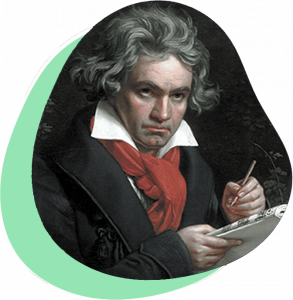
Practice broken chords in both hands and long held notes in the bass with one of the most famous pieces of music ever written for the piano.
Sign up for a 1 month free trial (no credit card details required) and learn Moonlight Sonata and other iconic piano pieces with Skoove.
Take a sneak peek of our lesson
Ludwig van Beethoven had quite a few hits that are still in great demand over 200 years later. This is perhaps the second most well-known (the first being Fur Elise). The original is in C# minor and in cut time, but there are many versions in different keys and time signatures, mainly to make it accessible piano students who long to play it.
It’s well known that Beethoven lost his hearing. It was a gradual loss which started when he was around 28 years old. The Moonlight Sonata was written when he was 31, so there would have been some symptoms at the time he wrote this. It was unusual to start with such a slow movement and end with such a fast one. It’s one of the many ways Beethoven pushed music from “classical” rules into a new era of music – the romantic era.
Cheat sheet
| Artist | Ludwig van Beethoven |
| Composer | Ludwig van Beethoven |
| Release Year | 1801 |
| Genre(s) | Classical |
| Difficulty level | Beginner |
| Instrument | Piano |
| Key(s) | Original: C# minor | Skoove lesson: D minor |
| Meter | Original: 2/2 | Skoove lesson: 12/8 |
| Techniques | Continuous broken chords in the left hand and then in the right hand. Long held notes in the bass. |
Play Beethoven’s beautiful Moonlight Sonata piano chords
Moonlight Sonata is certainly one of the top most recognizable and ubiquitous piano songs in the history of written piano music. You will instantly recognize the Moonlight Sonata chords from countless movies, plays, or advertisements – composers and producers have been using the brilliance of Beethoven to represent quiet, sadness and solemnity for many years, and will continue to for many years to come. The right hand arpeggios, the slow descending bass line, the beautiful and odd melody all combine to create the unique and haunting Moonlight Sonata piano chords.
Tips for playing the song
- Chords broken into single notes are called arpeggios
- When playing arpeggios approach them like chords, place all fingers over all notes and then play them one at a time, before repeating the pattern
- The descending bassline will go down further than you think, make sure you have plenty of space to play as low as you need to
- Skoove has simplified the time signature from triplets in 2/2 to 8th notes, re-written into 12/8 — twelve eighth notes in each measure, in groups of three
- The metronome built into the Skoove App will be helpful making sure you play each of these eighth notes in time
- Be careful to start in the right area of the piano, both hands begin very low.
Learn to play ‘Moonlight Sonata’ on piano step by step with Skoove! You can start your one month free trial now!
Interesting fact
Beethoven dedicated this work to his 16 years old student, Countess Giulietta Guicciardi. Beethoven was in love with her, but their romance eventually did not come to fruition.










